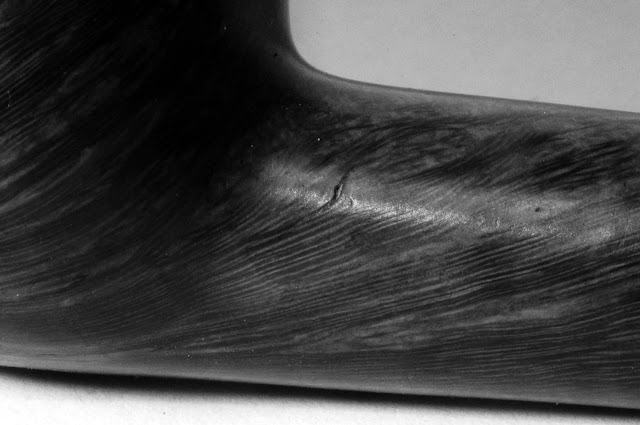This is today's project, a war-time issued GBD billiard. Once I've restored the bit and removed some of the eyars of dirt I'll post update pictures. However, I will be careful not to destroy the incredible patina this pipe has.
I have always thought that this pipe had all the makings of a high-grade. When I first picked it up I knew that it was special, but the lack of markings confused me, as did the small unfilled fissures. It was one of three pipes that I purchased from an antique shop in Atherton (Queensland, Australia) about 13 years ago. I love the grain, to me it 'sings', not many pipes do.
The pipe has been beautifully finished, has the metal GBD roundel, but lacks any markings on the stummel. The duel-diameter tenon is common (on my dateable pipes) from the 1920s - 1950s. The shaping of the billiard would point me to the 1930s or 1940s as the:
- cheeks fatten slightly lower in the bowl (earlier fatten in the middle and modern fatten towards the top)
- rear of the bowl is far flatter than the front (less pronounced difference in pre and post 1930s-1940s billiards)
- shank tapers subtly from the bowl to the bit interface
- shank is proportionally longer then many pre-1930s pipes and fatter than many post 1950s pipes
- shank has a beautifully machined - AND FINISHED (stained and polished) locating inner bevel
- rim has a single-plane inner bevel that spans the entire rim (common on pipes from this era).
But what of the lack of markings? Well, during the second world war many pipes were issued without markings as the focus was on volume to meet the needs of troops. Additionally, the fissures not being filled would point to the pipe being produced with speed in mind. Finally, the stummel is not perfectly symmetrical, so once again it has been produced quickly. However, the drilling and finish - WHERE IT MATTERS - (i.e. draught hole, tenon locating bevel, bit fit and finish) are all first-rate. Taking all of the information available I believe this to be a pipe from 1939-1945 and to have been issued to the troops. Finally, the area in which I purchased the pipe (it came off of a local farm) was used extensively by English, Australian and American troops for training and staging during WWII.
What do you all think?
 |
| Fissures in the front-bottom-left of bowl |
 |
| Fissure in the front-left of the shank |
 |
| You can see here both the shank and bowl fissures, none of which are deep or alter bowl/shank integrity. |
 |
| This shows, as well as I am able, the actual colour and patina of this beautiful pipe. |
 |
| Hard side-flash makes the rim look far worse than it is in real life. Still, not bad for all the years it has been smoked. |
 |
| Left-hand side of the pipe, rich, dense and beautifully figured grain. |
 |
| Note the majestic shallow single-plane bevel on the rim. Can you tell that I'm enamored with this pipe? |
 |
| Right-hand side of the pipe. Once again, dense and beautifully figured grain, a rare piece of briar to be sure. |
 |
| Note the slight bevel on the bit-end of the tenon, this mates perfectly with the inner-bevel on the shank. |
 |
| Metal (nickle) GBD roundel. It is still crisp, so the bit has not been polished much if at all over the years. |
 |
| Some tooth marks and depressions, but overall the bit is in great condition. |
 |
| The flared bit-end and the subtle rounding of the button ends (not from use, from the factory) are all marks of a high-quality pipe, as is the dual diameter tenon. |

Interesting post Hoot your theory sounds great.
ReplyDeleteIt was made fast but well and of high quality.